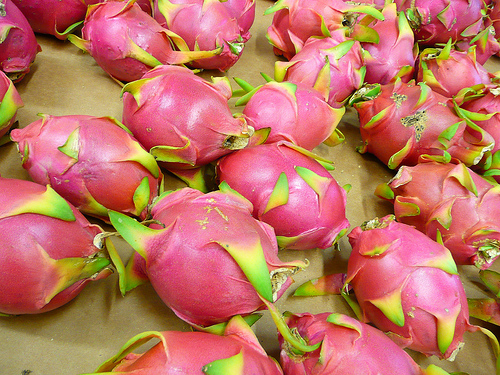Big, bright red things with interesting flaps and folds in the skin, like some kind of ornamental chinese lantern- is the dragonfruit (Hylocereus undatus). It first caught my eye at a local supermarket a week ago. I was not the only one hovering over the bizarre-looking fruits- at least four other people were smelling and touching them.

Priced at P120-150 a kilo, this fruit is fast becoming a hot new item in the market. A sure profit giver, scientists from the Institute of Plant Breeding (IPB) are encouraging farmers to plant dragonfruit in their backyards.
I learned that the dragonfruit is a climbing cactus whose fragrant white flowers bloom at night. In fact, it is popular as an ornamental in Hawaii and is called Queen of the Night, Moonflower or Lady of the Night because of its magnificent bell-shaped flowers.
Like other fruits, the dragonfruit or strawberry pear is very nutritious. It contains minerals, vitamins, and dietary fiber. It lessens cholesterol and is good for people with diabetes.
The ripe strawberry pear is found delicious, especially if chilled and cut in half so that the flesh can be eaten with a spoon. The juice is enjoyed as a cool drink. A syrup made from the whole fruit is used to color pastries and candy. The unopened flowerbud can be cooked and eaten as a vegetable.
Dragonfruit is also medicinal- the sap of its stems can be used as a vermifuge or dewormer but it is said to be caustic and hazardous. The air-dried, powdered stems contain B-sitosterol which is 30 times more effective than choline in breaking down cholesterol.
The dragonfruit plants can be cultivated using seeds, cuttings and pieces. They are easy to grow and maintain provided they are not overwatered. Like other cacti, they thrive best in well-drained soils such as sand and perlite and bloom best under full sunshine.
To cultivate the plant, stem cuttings can be prepared from plants that are 1/2 to 1 1/2 meter long. Then, these cuttings are stored in a dark area for a week before they are planted in plastic bags filled with a mixture of soil, manure and burnt rice hulls.
When the seedlings are big enough, they can be transplanted to a 30-cm thick plot with a wooden trellis for the them to climb on. They can also be allowed to climb a tree or a wall like other vines or scrambling plants.
Other pointers that are useful are:
1. Plant them in areas that are not infested with ants,
2. Make sure that the plants get enough sunlight
3. Let the branches hang to enhance flowering and
4. Avoid overwatering and letting the soil dry in between waterings, and,
5. Indoors-place them in full sunshine, outdoors- place them in a partially shaded area. And if the leaves develop “burned” spots, give them more shade.
Recently, the dragonfruit has already made its way into the European market and latest figures show cacti fruit sales are soaring across the world. Although consumers are sometimes skeptical, there is a market for new exotic fruits. Farmers can augment their income by planting special crops like these in their backyard or in their farms.
——————–
Source:
Pagtatanim ng Dragon Fruit by Drs. Rodel Maghirang, Gloria Rodulfo and Eufemio Rasco Jr., Special Crops Project-Vegetable Division, Institute of Plant Breeding, College of Agriculture, UP Los Baños at Telephone No. 049-536-3304 loc 217 and E-mail: rgm2000@yahoo.com
by Junelyn S. de la Rosa, BAR Chronicle, July 2002 Issue (Vol. 3 No. 13)
